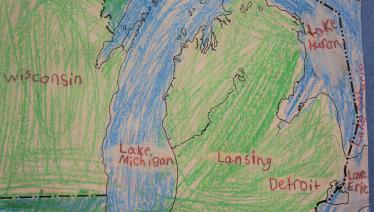Word problems in mathematics often pose a challenge for English language learners (ELLs). They require that students:
- read and comprehend the text of the problem
- identify the question that needs to be answered
- identify which information is important for solving the problem (and which information isn't)
- create and solve a numerical equation.
Many ELLs may have difficulty reading and understanding the written content in a word problem. For example, a student who is still learning English might not yet know key terminology needed to solve the equation. ELLs who have had formal education in their home countries may have strong math and computational skills, but their struggles begin when they encounter word problems in a second language that they have not yet mastered (Bernardo, 2005). For this reason it is recommended that students learn key terminology prior to attempting to solve mathematical word problems.
Key Benefits
Teaching ELLs: Tips for Math Teachers
Once English language learners know the key terminology used in mathematical word problems, it will be easier to learn how to write numerical equations. It is important for teachers to provide ELLs with opportunities to learn and practice key vocabulary words.
While key words are very important, they are only part of the process. Understanding the language in word problems is critical for all students. They need to know the meaning of words. But because words are often used differently and problems are set up differently, there are some cautionary messages. Here is an example of problem that uses "fewer than" to set up a subtraction equation.
Maria has 24 marbles, which is 8 fewer than Paolo has. How many marbles does Paolo have?
If we were to only focus on using key words, "fewer than" is a signal to pick out the numbers and subtract. The student may immediately make the conclusion that the answer is 16, but that is not what the problem is asking, and the child would be wrong. (The correct answer, by the way, is 32).
Research shows that if we ask students to only rely on knowing that certain key words signal specific operations, we can actually lead them away from trying to understand the problems. They will tend to look only for those words and whatever numbers are in the problem, even if they are not relevant to the answer. This will not help them be mathematically proficient later, even when they are proficient with English.
Although the finding on key words was done with regular students, the consequences for ELL students of relying on them is the same. They would not be able to solve the problem above. However, if teachers follow the suggested process of reading a problem several times (at lower as well as upper grades) and discussing what it means, students will understand. Another good tool is to teach them to draw or model the problems. To illustrate the problem above, you could state: "Here's Maria's 24." Then, draw 24 units, figures, shapes, etc. to represent 24. "Here's Paolo's; he has more because Maria has fewer than he does". Draw 24 units, figures, shapes, etc. to represent 24 and add 8 more. "So Paolo's has to come to more than 24. How many more? 8. So what is Paolo's total?"
The difference is between knowing the meaning of the words "fewer than" and using "fewer than" as a key to an operation. We want students to know the meaning of the words, but also to see them in the context of the whole problem.
Suggested Activities
Lower Grades
Practice problem solving daily by simply asking more questions. For example:
- How many students brought their homework today?
- How many more children brought their homework yesterday?
- We had 8 markers on the board, but now we only have 3. How many did we take away?
- How many animals are there in this magazine? How many are mammals? How many are birds? (introduction to fractions and percentages)
Continue to use key terminology daily and put it in context (e.g., less than, more than, difference, times, each, etc.). Show students how easy it might be to misunderstand the problem.
Upper Grades
- Read word problems slowly and carefully several times so that all students comprehend.
- If possible, break up the problem into smaller segments.
- Allow students to act out the word problems to better comprehend what they are being asked to solve.
- Provide manipulatives to help students visualize the problem.
- Take field or walking trips to figure out distances, speed, area covered, etc.
- Ask students to do surveys, interviews, hands-on research in real-world situations to figure out percentages, differences, and higher-order math skills.
- Allow students to make drawings or diagrams to help them understand problems.
Academic Vocabulary
In addition, it's important to keep in mind that:
- Some words in math problems may have multiple meanings ("yard", "plot")
- Some words may be homophones ("eight"/"ate")
- Students may need explicit instruction in key vocabulary
- Students may need some background knowledge to understand the topic of the math problem
You can see strategies for addressing these topics in our in-depth article, Math Instruction for English Language Learners.
Key Terminology
Addition + | Subtraction - |
|---|---|
combined | minus |
Multiplication x | Division ÷ |
multiplied | divided by |






